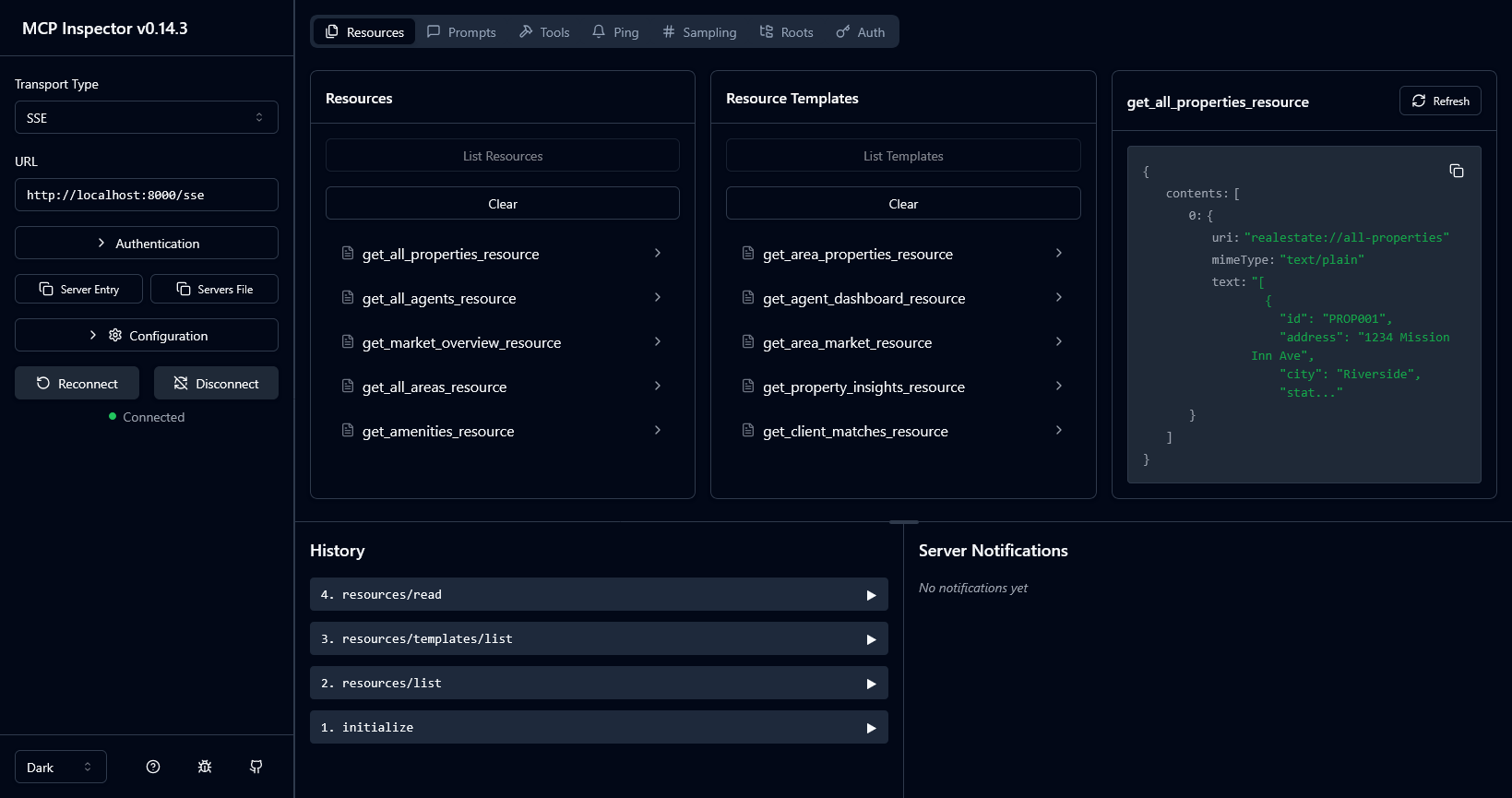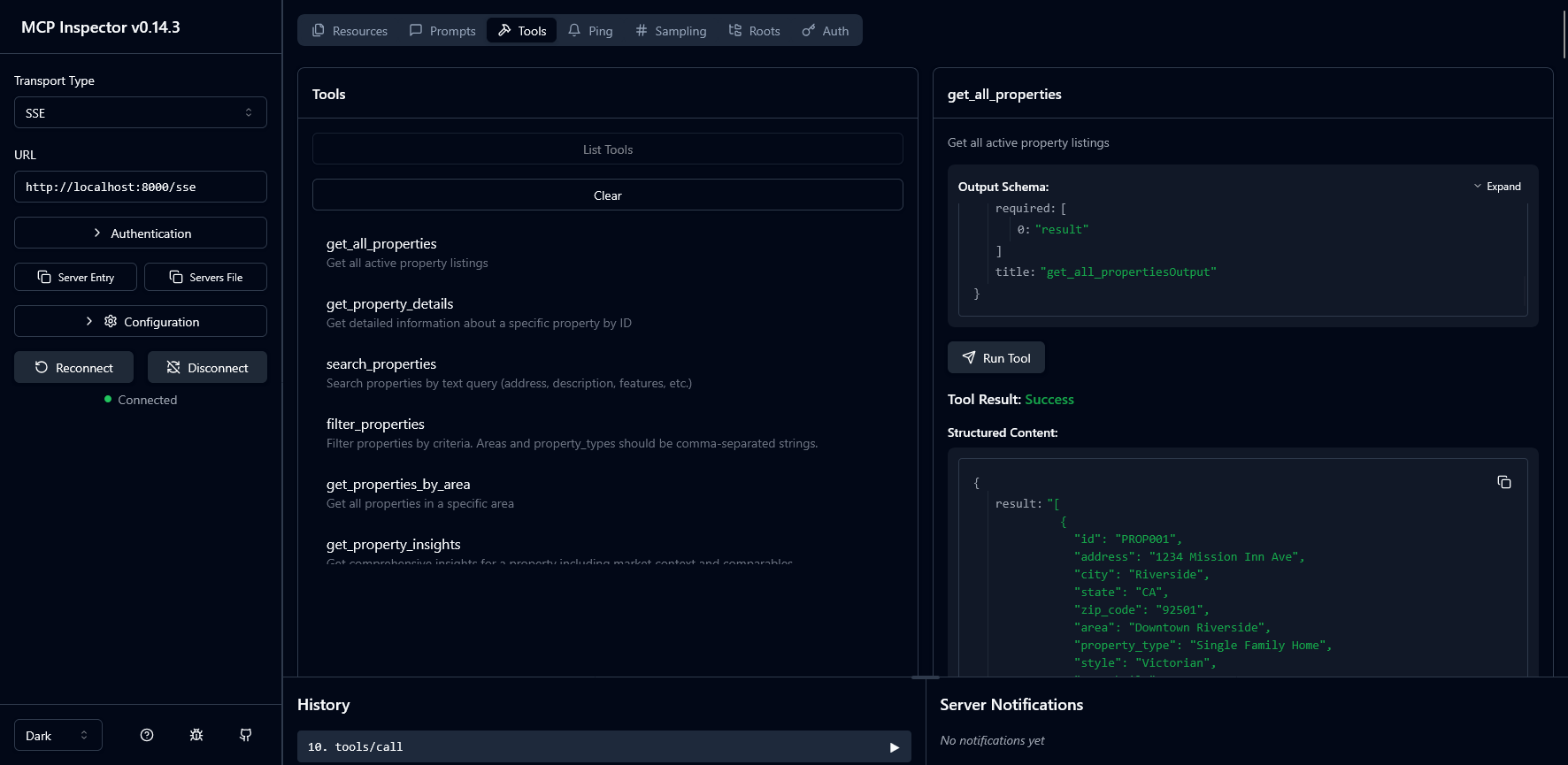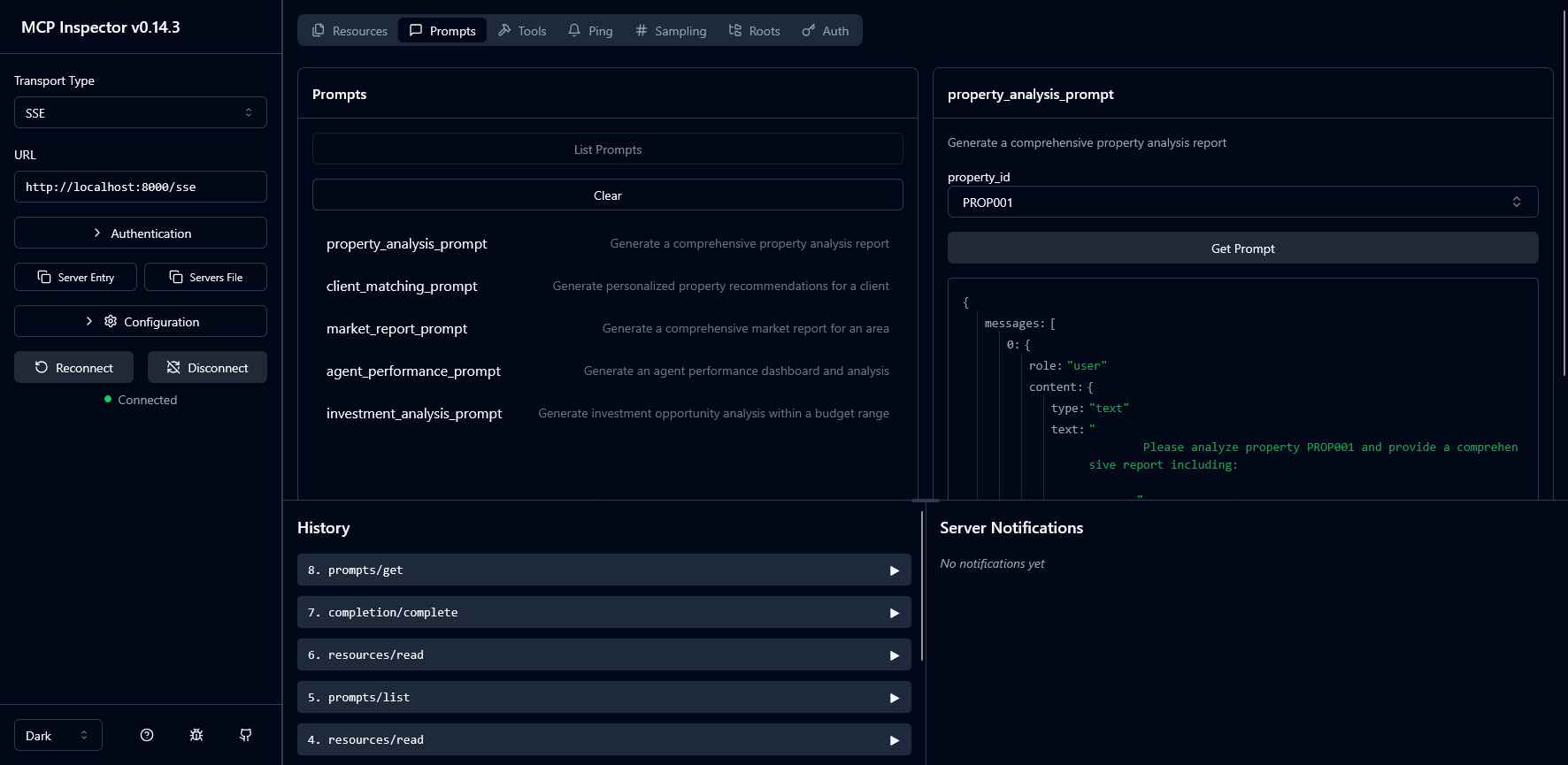
Domain MCP Reference
Real Estate MCP Server
Production-aligned protocol surface: 30+ tools, governed resources & deterministic prompt templates enabling acquisition, valuation & client advisory workflows without prompt sprawl.
- ▹Schema-first tool contracts
- ▹Deterministic prompt layer
- ▹Composable reasoning chains
- ▹Governed resource namespaces
Tools
30+
Resources
10+
Prompts
5+
Quick Navigation
Built for inspection, incremental extension & multi-model interoperability.
Real-World Workflow Examples
Complete end-to-end workflows demonstrating how real estate professionals leverage the MCP server through AI assistants for property analysis, client matching, and market intelligence.
Scenario
A real estate agent has a client looking for a Victorian home in Riverside under $800,000. The client needs at least 3 bedrooms, 2 bathrooms, and prefers areas with excellent schools for their growing family. The agent needs to quickly find matching properties, analyze market positioning, assess school districts, and provide a comprehensive report with property comparisons and investment potential - all while ensuring the search considers both current listings and recent comparable sales to provide accurate market context.
Scenario
An agent is preparing for a consultation with Sarah Johnson, a first-time homebuyer with a $600,000 budget. Sarah works downtown and wants a modern 2-3 bedroom property within easy commuting distance. As a first-time buyer, she needs education on the process, financing options, and market dynamics. The agent needs to match Sarah with suitable properties, prepare a comprehensive consultation framework covering buyer education, property options, and financial planning, while building a presentation that demonstrates market expertise and establishes trust for the long-term client relationship.
Scenario
An investor client is evaluating a potential multi-family property acquisition in the growing Riverside market. They need comprehensive market analysis covering current trends, rental yield potential, appreciation forecasts, and competitive positioning. The analysis must account for both immediate cash flow and long-term value appreciation, consider comparable recent sales, evaluate neighborhood development plans, and assess risk factors including market saturation and economic headwinds. The agent needs to deliver institutional-quality market intelligence that supports a data-driven investment decision within 48 hours.
This Real Estate MCP is a reference / exploratory implementation – a functioning case study validating protocol-driven AI capability surfaces (tools + resources + deterministic prompts). It is not a commercial product; the emphasis is architectural pattern proof, contract stability and cross-domain portability (now extended to relocation).
Interested in adapting the schema / layering for another vertical (finance, compliance, logistics) or extending multi-domain chaining? Reach out with scope & constraints and I can outline an incremental sequencing plan.
Iteration Update
This reference server seeded a second domain implementation
Core architecture, prompt scaffolds, tool taxonomy & dataset structuring patterns from this Real Estate MCP are now being reapplied to a Thailand Relocation MCP (visa pathways, budgeting, locality intelligence, settlement workflows). Reuse proves the portability of the protocol surface + schema-first layering.
We will publish a comparative evolution log (what changed, what stayed stable) after stabilizing the relocation dataset ingestion cycle.
Why a Protocol Surface (vs Ad-hoc RAG / Prompt Stuffing)
MCP formalizes AI interaction boundaries: instead of repeating brittle prompt bundles, structured tools + stable resources + deterministic prompts give you reproducible, governed reasoning. The real estate domain amplifies these benefits because multi-factor decisions (area fit, cost structure, ownership pathway, risk posture) demand selective, typed context - not token floods.
🧬Structured Fusion
Tools + prompts unify multi-factor property reasoning without token bloat.
🛰️Observable
Every call inspectable: parameters, latency, output schema.
♻️Low Drift
Deterministic templates + typed returns stabilize iteration cycles.
🧱Composable
Chainable primitives instead of monolithic opaque prompts.
Architecture Overview
Layered, schema-first design enabling deterministic tool invocation, composable resource retrieval and reasoning scaffolds through prompt templates.
🧱Protocol Layer
FastMCP server exposing tools, prompts & resources over SSE (future: WebSocket).
- •Tool registry
- •Prompt catalog
- •Resource resolver
- •Session state
🧩Domain Modules
Functional segmentation keeps reasoning coherent & reduces coupling across expansion.
- •Property module
- •Market module
- •Agent module
- •Client module
📂Resource Layer
Stable real-estate:// style namespaces for static + template resources.
- •Static JSON
- •Templated bundles
- •Version tags
- •Selective preload
MCP Inspector Views
Representative protocol-level inspection surfaces: resource registry, tool contract catalog, and prompt template layer.



Capability Domains
Functional groupings of tools and resources aligned to real-world decision & execution flows.
Property Intelligence
Search, comparables, structural attributes & value context.
- ▹Multi-criteria search
- ▹Comparable analysis
- ▹Listing normalization
- ▹Inventory snapshots
Market Analytics
Macro + micro market trends for investment or planning decisions.
- ▹Area metrics
- ▹Momentum signals
- ▹Pricing deltas
- ▹Historical trend merges
Client & Agent Ops
Operational backbone for pairing, pipeline planning & performance context.
- ▹Preference mapping
- ▹Match scoring
- ▹Agent performance frames
- ▹Engagement metrics
Transaction Modeling
Closing cost estimation, ownership frameworks & structural pathways.
- ▹Ownership structures
- ▹Cost decomposition
- ▹Scenario bands
- ▹Risk factors
Risk & Due Diligence
Checklist synthesis & advisory pattern outputs for safe acquisition.
- ▹Risk taxonomy
- ▹Checklist staging
- ▹Mitigation frames
- ▹Priority scoring
Area Intelligence
Granular neighborhood / area descriptors, cost & lifestyle factors.
- ▹Amenity vectors
- ▹Lifestyle tags
- ▹Cost multipliers
- ▹Education overlays
Schema-First Tool Contract Example
Every tool advertises an AI-legible contract (name, description, JSON schema). Below is an illustrative (condensed) contract powering property shortlist reasoning & subsequent cost / risk chaining.
Representative Tool Catalog
Not exhaustive - demonstrates semantic range and JSON contract patterns.
🔍Search & Filtering
- •search_properties
- •filter_by_attributes
- •list_new_listings
- •compare_properties
Returns structured lists with scoring metadata.
📈Market Insight
- •get_market_overview
- •area_trend_snapshot
- •price_momentum
- •inventory_pressure
Aggregated & normalized numeric indicators.
🧾Transaction Costs
- •estimate_closing_costs
- •ownership_cost_bands
- •transaction_scenario_breakdown
Cost components tagged & typed for modeling.
🛡️Risk & Checklists
- •get_due_diligence_checklist
- •risk_factor_matrix
- •compliance_flags
Structured risk surfaces for prompt fusion.
🤝Client & Agent
- •match_client_preferences
- •agent_performance_summary
- •portfolio_gap_analysis
Operates on abstracted behavioral vectors.
🗺️Area Intelligence
- •get_area_details
- •area_cost_multipliers
- •amenity_cluster_summary
Supports lifestyle & return blending.
Transport Strategy: SSE First, STDIO Compatible
SSE chosen for multi-client accessibility & browser tooling. The implementation keeps transport abstraction thin so STDIO embedding (desktop AI) or future WebSocket upgrade remains low-friction.
🌐Multi-Client
SSE supports browsers, terminals & inspectors concurrently.
⚡Low Overhead
No websocket handshake complexity; simple event stream.
🔌Desktop Ready
Abstraction allows STDIO swap for local embedded clients.
🛠️Inspectability
Curl & devtools friendly during iteration.
Incremental Roadmap
Focused expansion - prioritizing compound leverage over surface sprawl.
🧪Scenario Engine
PlannedComposable scenario deltas (rent vs buy vs hold).
- ▹Delta modeling
- ▹Assumption sets
- ▹Outcome scoring
🧬Feature Embeddings
ExploringVector attributes to enhance similarity & clustering.
- ▹Amenity embeddings
- ▹Lifestyle vectors
- ▹Cross-area mapping
📡Live Feed Hooks
FutureOptional ingestion of event-based market signals.
- ▹Price ticks
- ▹New listing deltas
- ▹Supply pressure
🛡️Policy Guardrails
PlannedSensitive operation gating & escalation policies.
- ▹High-value lock
- ▹Audit tags
- ▹Redaction filters
🤖Auto-Test Harness
In ProgressPrompt + tool contract regression automation.
- ▹Snapshot baselines
- ▹Semantic drift alerts
- ▹Schema diff triggers
🗄️Delta Storage
ExploringTemporal layering of resource changes.
- ▹Resource diff index
- ▹Time-travel queries
- ▹Staleness scoring
Implementation Layers
Three composable layers keep concerns separated and evolution safe: protocol surface (MCP contract), business logic (domain services, validation), and data integration (file, API, DB sources). Below: condensed examples mirroring production patterns.
🔌Protocol Layer
Registers tools, prompts & resources; enforces JSON schema; mediates transport (SSE / STDIO).
@server.list_tools()
async def list_tools():
return [Tool(name="search_properties", description="Find properties", inputSchema={"type":"object"})]
⚙️Business Logic
Pure functions & services: filtering, scoring, market context enrichment, safety rules.
async def shortlist(props, max_price):
return [p for p in props if p["price"] <= max_price]
🗂️Data Integration
Adapters unify CSV, API, scraped and cached datasets into normalized access patterns.
class PropertyRepo:
async def search(self, **kw):
# compose file + API layers
...
Tool Semantics & Design Principles
Tools model business intents, not transport or storage. Naming & description quality materially affects model invocation accuracy. Each contract answers: when should the model call me? what do I return? how risky is my side‑effect?
🎯Intent Naming
Prefer match_client_preferences over query_clients.
🧪Schema Guardrails
JSON schema reduces malformed calls & clarifies optional vs required parameters.
📦Structured Returns
Return small typed objects; avoid giant free‑text blocks for downstream chaining.
🔁Composable Granularity
Decompose: fetch → enrich → score; model can branch / skip steps.
Prompt Templates vs System Prompts
Prompt templates here are explicit, user-invoked analytical frames (investment analysis, comparative area study). They differ from opaque system prompts by being inspectable, versionable and parameterized.
Template Properties
- ▹Deterministic structure
- ▹Parameter binding (risk, horizon)
- ▹Low diff noise in review
- ▹Model-agnostic reuse
Why It Matters
- ▹Reduces hidden behavior drift
- ▹Encourages analytical consistency
- ▹Enables audit & governance
- ▹Supports multi-tool chaining clarity
Key Feature Groups
Surface breadth anchored to real workflows - each grouping aggregates narrowly scoped, composable tool contracts.
7 tools
6 tools
7 tools
9 tools
3 tools
Security & Access Control
Guardrails treat every tool call as a permissioned action with observability. Narrow contracts + explicit auth + audit trail & rate limiting.
Authentication
Per-session tokens; rotation & revocation supported.
Authorization
Role → capability mapping; deny by default.
Audit & Telemetry
Structured logs: tool, latency, arguments hash.
Rate / Quotas
Adaptive ceilings by role & risk category.
Business Impact
Shift from ephemeral prompt stuffing to persistent capability surface: repeatable, inspectable, governed reasoning over your proprietary context.
Before MCP
- –Generic model responses
- –Context lost per turn
- –Manual data collation
- –Unbounded prompt drift
After MCP
- +Live domain data access
- +Composable reasoning chains
- +Governed evolution & audit trail
- +Faster feature iteration loops
Future & Getting Started
Emerging Directions
- ▹Multi-server orchestration
- ▹Autonomous action gating
- ▹Adaptive tool surfacing
- ▹Industry reference catalogs
Start Sequence
- Pick one narrow workflow
- Model 3–5 intent tools
- Add a single prompt template
- Integrate live data path
- Add auth + basic audit
- Ship & inspect; iterate
Context & Approach
This server extends a sequence of practical AI infrastructure explorations - moving from isolated prompt craft → targeted fine-tunes → protocol-governed integration. Each stage reinforced the same constraint: leverage arises from reliable, structured access to differentiated context.
Prompt Template Layer
Deterministic scaffolds orchestrating multi-tool reasoning frames - pure functions with predictable diff behavior.
🧪investment_opportunity_brief
Synthesizes property + market + risk vectors into a decision frame.
- ▹Structured sections
- ▹Risk emphasis
- ▹Scenario variants
🧪client_fit_report
Preference-weighted matching rationale & shortlist reasoning.
- ▹Score breakdown
- ▹Deltas
- ▹Next actions
🧪area_comparison_matrix
Factor-weighted cross-area differentials.
- ▹Factor weighting
- ▹Relative scoring
- ▹Suitability tags
🧪ownership_structure_advisor
Compares ownership paths by complexity, protection & cost.
- ▹Structure matrix
- ▹Decision criteria
- ▹Risk flags
🧪due_diligence_brief
Phase-indexed checklist with escalation notes.
- ▹Phase grouping
- ▹Flag severity
- ▹Mitigation guidance
Data & Resource Model
Stable resource namespaces & incremental refresh patterns keep intelligence fresh without ballooning prompt budgets.
📂Static Datasets
Canonical JSON snapshots versioned for diffable change.
- •Areas index
- •Ownership structures
- •Cost taxonomy
🧬Derived Artifacts
Computed blends persisted for reuse & speed.
- •Price momentum
- •Risk factors
- •Amenity clusters
🧱Template Resources
Parameter-driven resource blueprints.
- •Scenario frames
- •Checklist variants
- •Comparative shells
♻️Refresh Layer
Incremental update orchestration & invalidation.
- •Daily rollups
- •Manual triggers
- •Isolation staging
Operational & Governance Layer
Inspection, safety and iteration mechanisms ensuring controlled evolution rather than prompt drift.
🛰️Observability
Structured logging & tool execution tracing.
- ▹Tool call envelopes
- ▹Latency buckets
- ▹Error taxonomy
🧪Regression Harness
Snapshot + semantic diff tests for prompt outputs.
- ▹Prompt snapshot
- ▹Schema validation
- ▹Delta alerts
🔐Access Control
Capability gating & surface isolation.
- ▹Role mapping
- ▹Read scoping
- ▹Prompt allow-list
🗂️Change Management
Version tagging & rollout staging.
- ▹Schema bump
- ▹Shadow deploy
- ▹Rollback hooks
🪵Drift Detection
Heuristic checks for anomalous output drift.
- ▹Content signature
- ▹Variance thresholds
- ▹Human review queue
⚖️Risk Controls
Guardrails for sensitive or high-impact tools.
- ▹Rate shaping
- ▹Input validation
- ▹Escalation gating
Example Multi-Tool Flow
A composite property acquisition planning call pattern (tool + prompt chaining).
Want a domain-specific MCP server (finance, logistics, compliance) or to extend this pattern? Share scope, data maturity and target workflows - I'll return an initial sequencing plan.
Start a Project